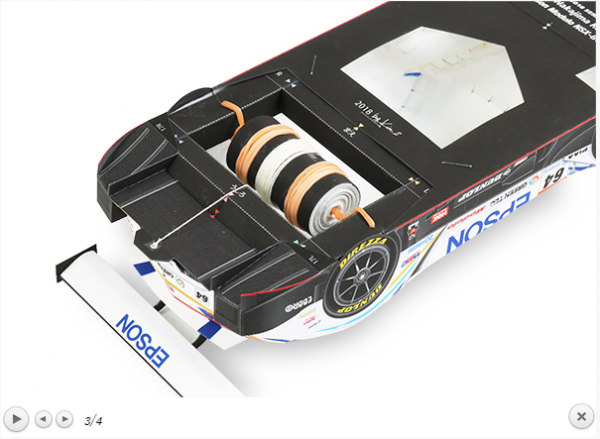
 |
|
#1
|
||||
|
||||
|
Rubber motor
https://www.epson.jp/sponsor/nakajima/craft/
 I'm not into model racing cars at all, but this one comes with a neat rubber band motor idea that could be incorporated into many other models.
__________________
Keep on snippin' ... Johnny |
| Google Adsense |
|
#2
|
||||
|
||||
|
That is (or at least seems to be) a most ingenious idea. At first I couldn't undertand at all how it would work, but then I saw how it would work like those little toy cars that you press and drag backwards, then release.
But how on earth could I use that for propelling an aircraft propeller, I wonder. Seems like a smaller version of the standard rubber motor for model airplanes still would be the best solution. Or surprise me! - Leif
__________________
My files in downloads. |
|
#3
|
||||
|
||||
|
Rubber Motor in an Airplane
Leif and John -
I THINK the motor could easily be mounted in a stick and tissue flying model, but I do not see any advantage in the case of most aircraft with long fuselages. Braided rubber would be more efficient and less complex. But it could be done, and might have applications for pod-mounted engines or aircraft with very short noses. I just realized that in my sketch, I placed the engine too far forward. As drawn, there would not be room for the prop hook once the nose block was in place, but I think you can get the idea. Don |
|
#4
|
||||
|
||||
|
Thanks for the sketch, Don! Much appreciated, and I do get the idea.
Although, what I don't understand is, where would the loose end go, the one that you tension? Or have I misunderstood everything again...  Leif
__________________
My files in downloads. |
|
#5
|
||||
|
||||
|
Quote:
How about a rubber band counter-rotating design?  Somewhere have an autopilot design for free flight models as well. Mike |
| Google Adsense |
|
#6
|
||||
|
||||
|
Hi Guys,
We used to build rubber powered planes all the time as a kid. I just googled "rubber powered free flight model airplanes" and took a trip down memory lane! Pretty cheap fun. Seems like it could be adapted to our style of paper model. Rick |
|
#7
|
||||
|
||||
|
I am probably the one misunderstanding, but I THINK one of the ends of the rubber band that is attached to the car chassis would be secured to one of the fuselage formers (the third one in my sketch) and the other would be attached to the prop hook. There would be no need for the string, since you are using the power of the rubber band directly.
You would tension the rubber band by using a rubber motor winding device or through the time-honored technique of turning the prop backwards until the required degree of tension has been achieved. It seems to work in my mind, but I am not an engineer or a mechanic and may very well be missing something obvious. Don |
|
#8
|
||||
|
||||
|
Quote:
it looks like you're correct. One advantage to this design would be the weight forward for CG purposes, might not have to add weight to balance for flight, on the other hand you might have to add weight to the tail. I tried to make a rubber band powered paper airplane once, many years ago. The problem was the cardstock by itself could not handle to torque/tension of the tightened rubber band, it warped and crushed the paper. On the original post you can see the rubber band anchored by the frame rails, wonder if they have some kind of support (balsa or basswood) to stop the band from crushing the cardstock. Mike |
|
#9
|
||||
|
||||
|
Kind of neat way to propel a car.
I am slowly translating the text in the how-to pdf. The Japanese letters are not actual text, but are graphics so they have to be copied, saved as pictures, run through an OCR process, translated, then added to the pdf. Some of the translations so far are quite an adventure in understanding. Gotta love online translators. 
__________________
~Doug~ AC010505 EAMUS CATULI! Audere est Facere THFC 19**-20** R.I.P. it up, Tear it up, Have a Ball |
|
#10
|
||||
|
||||
|
One day someone will offer an efficient Japanese to English translater app. Chinese / English translaters are getting better mainly because relatively few Chinese speak English, so they need to translate in order to rip off Western designed goods.
 As mentioned, Japanese characters are often inserted as picture graphics not as text which makes it difficult for any AI to read them. I don't know if this is deliberate or just incidental, but after a long American domination of the country you'll be hard pushed to find any Japanese that don't have a rudimentary understanding of English, even if they do often refuse to converse with us in it. As mentioned, Japanese characters are often inserted as picture graphics not as text which makes it difficult for any AI to read them. I don't know if this is deliberate or just incidental, but after a long American domination of the country you'll be hard pushed to find any Japanese that don't have a rudimentary understanding of English, even if they do often refuse to converse with us in it.
__________________
Keep on snippin' ... Johnny |
| Google Adsense |
 |
|
|